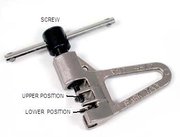Chain tool
|
|
This tool is required for removal and installation of the chain on a bicycle with derailleur gears, for maintenance or replacement. Bicycles with fixed gears front and rear, for instance the widely used coaster and three speed bikes, do not require this as they have a master link on the chain which holds the pin in place with an easily removable c-clip; this protrudes, however, and would interfere with the smooth operation of a derailleur system. This tool is used, however, should it be necessary to lengthen or shorten any type of chain.
As can be seen, the chain tool has two positions where a chain can be inserted perpendicular to the tool, one close to the movable screw portion, and one lower down just above the fixed end. In each position, there are a pair of protruding "ears"; one fits into the center of one link of the chain, the other fits into the center of the next link, holding the pin between the links aligned in the center of the groove running down the center of the tool, so that the tip of the movable screw can press vertically on the end of the pin. The end of the screw is slightly narrower than the pin, so that it can press the pin through the link. Often the end of the screw is a removable piece which can be replaced when worn.
In use, the chain is first placed into the lower position of the tool and the screw is turned in, pressing the pin through the top plate of the outer link and almost all the way through the center of the roller on the inner link, leaving just enough pin protruding that the inner link can be snapped free with a bit of pressure. This leaves the pin still aligned firmly vertical by the bottom plate; the pin should never be totally pushed through the bottom plate because it is then no longer fixed in the vertical axis and becomes almost impossible to re-insert. Even if the pin is merely pressed flush with the bottom plate it becomes more difficult to work with, as the chain now has to be held in alignment during reassembly, in contrast to leaving just enough of the pin protruding into the inner link to allow it to be snapped together by hand.
To reassemble, the chain is placed in position on the bicycle and the inner link snapped over the pin as described; the screw on the tool is now backed almost all the way out, and the chain is once more placed on the lower position of the tool, but reversed: this time with the pin protruding upwards, towards the screw. Now the screw is turned in again, pressing the pin down but this time inwards through the roller and back into the other outer plate, leaving the chain assembled as it was in the first place. Examination of the relative amount of protrusion of the pin on either side of the outer links of the chain determines when to stop.
Now, the upper position of the tool, with the chain held next to the screw, comes into play. The previous reassembly procedure usually leaves the outer plates of that link of the chain pressed tightly against the roller of the inner plates; this results in a "stiff link" which will tend to skip when shifting. To relieve this condition, the screw is backed almost all the way out once again, and the link of chain with the just-inserted pin is moved to the upper position of the tool. The screw is now advanced again, but only slightly, to press the pin forward just a tiny amount. Since the lower outer plate is not supported in this position of the chain on the tool, the pin is not pressed through the lower plate but only through the upper plate. Instead, the lower plate moves with the pin, relative to the upper plate, creating a larger separation; a very small movement is enough to release the pressure of the outer plates against the inner plates, freeing the "stiff link". This procedure can be used to free any "stiff links" which occur spontaneously, as well.
The tool is used similarly either to remove a segment of chain to shorten it, or to join two segments of chain to make a longer one. If neither piece to be joined has a pin protruding from one side to enable it to be joined in this fashion, then one inner link must be removed, leaving that pin protruding for use to join to the other segment of chain.
The design pictured here is for chains where the links have flat plates. For chains with complicated shaped plates designed to facilitate smooth shifting, specific chain tools are available which are identical in design and operation, but have the ears protruding into the chain shaped in cross section to fit the links of the particular chain in question precisely, so as to hold the pin in the all-important vertical alignment with the screw of the tool.

